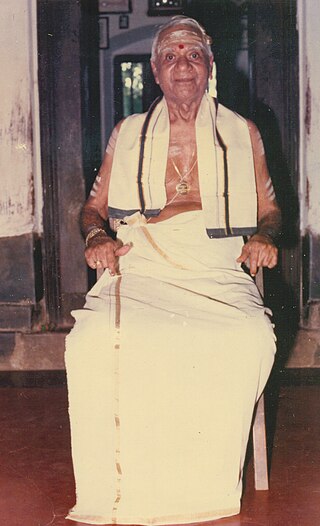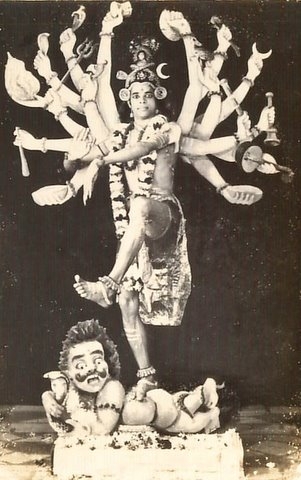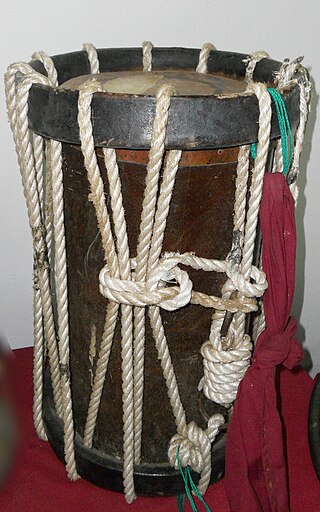
Koodiyattam is a traditional performing art form in the state of Kerala, India. It is a combination of ancient Sanskrit theatre with elements of Koothu, an ancient performing art from the Sangam era. It is officially recognised by UNESCO as a Masterpiece of the Oral and Intangible Heritage of Humanity.
Perumanoor Gopinathan Pillai, more popularly known as Guru Gopinath was a well known actor-cum-dancer. He is well regarded as the greatest preserver of the dance tradition. He is a recipient of the Sangeet Natak Akademi Award, the Kerala Sangeetha Nataka Akademi Fellowship, and the Kerala Sangeetha Nataka Akademi Award.
Kerala Natanam is a new style of dance that is now recognised as a distinct art form evolved from Kathakali, a form of Indian dance-drama. The Indian dancer Guru Gopinath a well-trained Kathakali artist and his wife Thankamani Gopinath who was the first student of Mohiniyattam in Kerala Kalamandalam developed a unique structure for teaching and performing classical dance forms of India whose origins are from Kathakali. Solo, duets, dance dramas and traditional folk dances were the material they chose.
Vinodini Sasimohan is the Chief Administrative Officer of Viswa Kala Kendra, Thiruvananthapuram, India. She was a child artist in Malayalam cinema. Her role as Goddess Devi Kanya Kumari in the film Devi Kanyakumari was noteworthy.
Kavalappara Narayanan Nair (1882–1948) was a prominent 20th-century Kathakali artiste and tutor who specialised in the Hanuman roles of the classical dance-drama from Kerala in south India.

Guru Mani Madhava Chakyar (15 February 1899 – 14 January 1990) was a celebrated master performance artist and Sanskrit scholar from Kerala, India, considered to be the greatest Chakyar Koothu and Koodiyattam artist and authority of modern times. He was considered as the authority of Abhinaya and Nātyaśāstra.

Sangeet Natak Akademi is the national level academy for performing arts set up by the Government of India.

The Indian state Kerala is well known for its diverse forms of performing arts. The various communities in Kerala contribute to its rich and colourful culture. The most important traditional art forms of Kerala are Kathakali, Kalaripayattu,Mayilpeeli Thookkam, Koodiyattam, Theyyam, Mohiniyattam, Thullal, Padayani, Pulikali, Thiruvathirakali, Chakyarkoothu etc.
Pakalkuri is a charming village situated in the eastern part of Varkala Taluk in Thiruvananthapuram District in Kerala, India. It is situated 20km east of Varkala Town on the banks of the river Ithikkara and well known for its serene beauty and landscape. The river Ithikkara, which originates from the Western Ghats, separates Thiruvananthapuram and Kollam Districts at Pakalkuri in its meandering to the Arabian sea.

Nātyakalpadrumam is a book written by Guru Māni Mādhava Chākyār, considered the greatest exponent of Koodiyattam and Abhinaya in Kerala, about all aspects of ancient Sanskrit drama theatre tradition of Kerala—Kutiyattam. It was first published in Malayalam (1975) by Kerala Kalamandalam, with financial assistance of Sangeet Natak Academi, New Delhi. This work serves as a reference to both scholars and students. The entire book is written in the old Sanskrit text style closely following Nātyaśāstra. The structure and content of the book alike illustrate the knowledge of the author in both Sanskrit and Nātyaśāstra. The work received the Kerala Sahitya Academy Award in the year 1975. A Hindi translation has been published by the Sangeet Natak Akademi, New Delhi.

Sunanda Nair is an Indian dancer trained in Mohiniattam. She did her master's degree in this dance form from Nalanda Nritya Kala Mahavidyalaya affiliated to the University of Mumbai. She has completed her PhD from University of Mumbai for her thesis "Intrinsic Lyrical Feminism in Mohiniattam". She was born in Mumbai, India.
Kalamandalam Krishnan Nair was a Kathakali dancer from Kerala in India.

Pattikkamthodi Ravunni Menon (1880–1948) was a pivotal figure in the history of Kathakali, having played a crucial role in remoulding and refining its grammar in the famed Kalluvazhi tradition of the classical dance-drama from Kerala in south India. He was trained in the art form at a culture-patronising Namboodiri mansion in Vellinezhi near his home.

Sadanam Krishnankutty is a performer of Kathakali, a classical dance-drama form of Kerala, South India. A recipient of Kerala State Kathakali award and Kalamandalam fellowship, he has donned a wide range of characters in his acts. He received the Kerala Sangeetha Nataka Akademi Award in 2002, the Sangeet Natak Akademi Award in 2007, Honorary D.litt from Thunchath Ezhuthachan Malayalam University, Thirur, Kerala in 2021 and the Sangeet Natak Akademi Fellowship in 2021.

Guru Chandrasekharan (1916–1998) was an Indian classical dancer, choreographer and instructor of Kathakali. He was born in Trivandrum, India in 1916. His father was N.K. Nair, an artist and notable oil painter. Guru Chandrasekharan held tenure at the Visva Bharati University (Santiniketan) from 1947 to 1950, where he was a Professor of Classical Dance, focusing on Kathakali.

Sadanam Divakara Marar was an Indian percussionist, known for his scholarship on sopana sangeetham, marappani, parisha vadhyam and thimila paani and his mastery over various temple and ritual percussion instruments of traditional Kerala music.

Sangit Bhavana, of Visva-Bharati University, Santiniketan, started functioning as a part of Kala Bhavana in 1919 and as a separate institution in 1933. It was established by the Nobel laureate Rabindranath Tagore.

Chemancheri Kunhiraman Nair, also known as Guru Chemancheri was an Indian Kathakali actor. He spent over eighty years learning and teaching and performing Kathakali, a major form of classical Indian dance. The Government of India awarded him the fourth highest civilian honour, Padma Shri in 2017.

Gopika Varma is a Kerala born Mohiniyattam dancer and dance teacher who is settled in Chennai, Tamil Nadu, India. She received several awards including Sangeet Natak Akademi Award, Kerala Sangeetha Nataka Akademi Award and Kalaimamani.
Mangat Mulaykkal Thankamani, known by her married name Thankamani Gopinath was a prominent Indian Mohiniyattam dancer and dance teacher from Kerala. The wife and co-dancer of Guru Gopinath, she was the first student of Mohiniyattam from Kalamandalam. Thankamani is considered as one of the important icons in the history of women's progress in Kerala, who learned Mohiniyattam at a time when learning and performing dance was considered unethical for girls in Kerala. She has also starred and sung a song in the 1941 Malayalam movie Prahlada.











